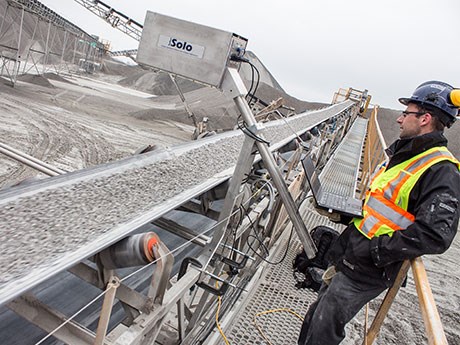WipWare launches blast fragmentation analyzer
The efficacy of underground and surface blasting is getting more predictable with the help of an innovative North Bay company.
WipWare Inc., which designs and manufactures photoanalysis software and equipment that examines and measures materials in mining, aggregate, forestry and other industries, recently launched BlastCast®, a blast fragmentation forecaster.
Company president Tom Palangio says many clients use the WipFrag software he pioneered to measure blast fragmentation. “In the mining industry, if you break the rock adequately at the start, it pays off all the way along downstream,” he said.
While there are other tools that may help predict blast fragmentation, they are complicated and people don’t use them much, he said.
“We wanted to create something that was so simple, people would actually use it more.”
Mining or aggregate companies can analyze rock fragmentation with WipFrag technology, then make adjustments to blasting parameters, using BlastCast to predict the results.
“You can actually change variables easily, using sliders, and it will tell you the cause and effect of different things. If you expand the burden or the spacing, it will tell you right away what the effect on the result is going to be,” Palangio said.
“They can simulate different things and it will predict for them what the final outcome is.”
After each blast, fragmentation can be compared to the predicted model. Adjustments can be made in subsequent blasts to optimize results, which get more predictable the more the software is used.
The new forecasting tool can help save money and boost productivity.
“If you don’t break rock very well with explosives, it costs you a lot downstream to remediate that. You use a lot more energy in your crushers, your milling and your grinding, and your other downstream processes,” Palangio said.
While blast optimization can save drilling time and explosives, if it can reduce maintenance costs and increase throughput, it pays for itself quite quickly, he says.
BlastCast is an enhancement of the most recent WipFrag software. Existing users can simply update their software to the latest version to take advantage of the BlastCast module at no cost.
Blasting has been more of art than a science, but in the last 20 years, much more has been learned about it, Palangio said.
“People are starting to spend a little more time looking at the variables because mining is so competitive these days. An ounce of gold is worth the same in Sudbury or in Timmins, as it is in Papua New Guinea. In order to be competitive with labour rates and with automation, you really have to use the latest in technology.”
Optical granulometry
WipWare invented optical granulometry nearly 30 years ago at the University of Waterloo. Palangio, who worked in the explosives industry for many years, developed WipWare’s proprietary photoanalysis software in 1996. It’s now used by dozens of mining and aggregate companies, engineering firms, oil companies and explosives manufacturers.
WipWare systems employ cameras, designed to withstand the rigours of harsh environments, to photograph and collect detailed measurements of materials such as blasted rock, aggregate, wood chips or seeds.
The technology can analyze material in place as it’s moving along a conveyor or dumped from a truck, and relay information in real time to operators controlling milling, manufacturing or grading.
Operators can use the information to optimize processes, save money and reduce maintenance. Although Palangio is not privy to the actual cost savings his technology achieves, he hears about them anecdotally.
“People will phone us, maybe three weeks or a month after they’ve put the technology in, and they’ll say, ‘We’re really pleased with how it’s working. In fact, it’s paid for itself already,’” he said.
Most clients, he noted, are paying more than $1 million a month for electricity.
“So, if you can put a dent in that, it pays for itself very, very quickly.”
WipWare installed its first system in Russia last fall. The automated analysis technology for measuring size distribution of particle fragmentation on multiple conveyor belts was purchased by the Severstal iron ore operation in northwestern Russia.
As a major mineral producer, Russia is a potentially huge market for new mining technology. But that market has been difficult to access by many North American firms because of culture, language and various trade barriers, Palangio said.
“The Russians, along with the rest of the world, are starting to look at better ways of doing things and, certainly, they’re very receptive to new technologies,” he said. “It was a real success for us to be able to introduce a few systems over there. Their acceptance of them has been great and we’re looking for a lot more business over there.”
While he’s been watching news about the recent turmoil between Russia and Ukraine, and the resulting sanctions by Western governments, he has not seen any effect on business. “I don’t know how or if it will affect trade with the former Soviet Union,” Palangio said.



